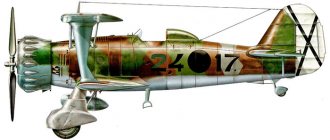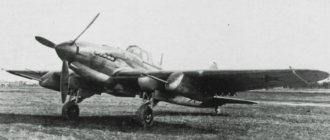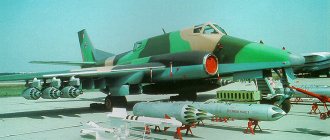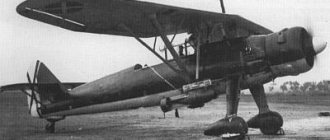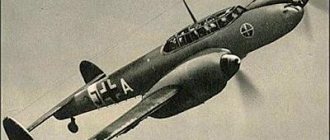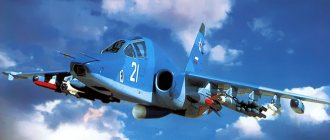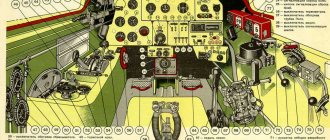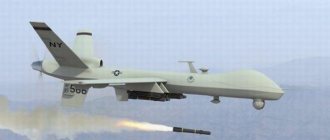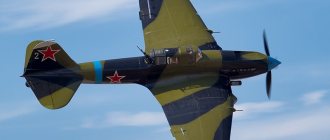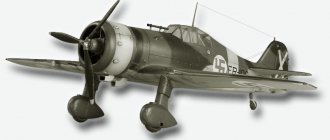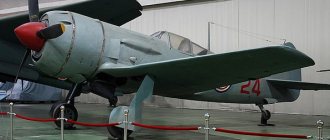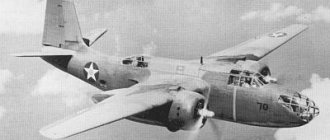Luftwaffe attack aircraft Henschel Hs-129
In April 1937, the Reich Ministry of Aviation prepared tactical and technical requirements for a promising attack aircraft. It was envisaged to create an aircraft capable of operating at low altitude over enemy positions. For this purpose, it was necessary to protect the vital elements of the vehicle with armor - the cockpit, power plant, fuel tanks. The small arms were supposed to be quite powerful: two 20 mm MG FF cannons and several 7.92 mm machine guns. The power of the power plant was supposed to be in the range of 900-1100 hp, and preference was given to a twin-engine design as providing better survivability over the battlefield. A second crew member serving the defensive rifle installation was not provided for by the requirements - the aircraft was supposed to be single-seat, defenseless from attacks from fighters from behind and above. Of the four companies that participated in the competition, two reached the finals - Focke-Wulf with a modified short-range reconnaissance aircraft Fw-189 and Henschel with a specially designed twin-engine monoplane Hs-129. The victory of the Henschel product in the competition was not at all determined by its high qualities - the Hs-129 simply turned out to be slightly less bad than the assault version of the “frame”.
The Hs 129V1 prototype was tested from May 26, 1939, and was joined by two more prototypes in November-December 1939. Deliveries of pre-production aircraft began in the summer of 1940. The total production volume (including prototypes) exceeded 870 aircraft.
Tank destroyer attack aircraft
Henschel
© Mikhail Bykov
Hs 129B-2, headquarters unit of the 1st Luftwaffe assault squadron (Stab/SchG1) Stalingrad winter 1942-43.
The Henschel Hs-129 was the only World War II aircraft designed specifically to fight tanks. The first production Hs 129A-1 vehicles were equipped with Argus As-410A-1 engines, developing 465 hp at a speed of 3100 rpm.
Chief Engineer Fr. Nikolaus understood that flight performance could be improved by installing a more powerful engine.
The Gnome-Ron 14M 04/05 engine developed a power of 700 hp at takeoff, and at an altitude of 4000 m its power was 660 hp. Simultaneously with the work on the Hs-129V-3, the conversion of 16 Hs-129A-l aircraft, which were now designated Hs-129B-0, to French engines began. The third prototype was destroyed during flight testing, after which it was replaced by one of the Hs-129B-0 aircraft. The installation of heavier engines required modifications to the wing design in order to maintain the aircraft's alignment within acceptable limits. To do this, it was necessary to abandon the kinks of the leading and trailing edges of the wing and move them to the rear part of the fuselage from the nose part of the equipment. The more powerful engines largely lived up to the obligations placed on them, however, the pilots from Rechlin were still prejudiced towards the aircraft - their wishes for a cramped cockpit and poor visibility from it remained on paper.
The design of the armored capsule reflects the Henschel company's many years of experience in the production of armored vehicles for the ground forces; it was this production that the company's management considered the main one. Nikolaus and his team wanted to provide the pilot with a good view down and forward through the use of small tank-type viewing devices; when using such devices, a strict requirement was imposed - the distance between the eyes and the glass should not exceed 30 cm. The requirement that the pilot's head be close to the windshield of the canopy entailed the need to “stretch” the pilot’s legs into the forward part of the fuselage, and the desire to minimize the weight of the armored capsule resulted in a low seat position. As already noted, the width of the upper part of the armored capsule was determined by the width of the pilot’s shoulders - “any way he got through.” On the exceptionally small instrument panel there was no room for engine control instruments, which had to be placed on the inner sides of the engine nacelles. The small size of the sliding segment of the cockpit canopy greatly limited the visibility to the sides, which caused problems when taxiing and when flying in formation. There was no talk at all about visibility into the rear hemisphere. The side glazing of the canopy on pre-production aircraft was made somewhat larger, however, according to the pilots, the visibility to the sides was still unsatisfactory. The new canopy canopy, together with the shorter forward fuselage, has a positive effect on forward and downward visibility. Poor visibility from the pilot's seat to the sides remains the price to pay for good protection. The transparent parts of the lantern were made of armored glass 75 mm thick. Behind the pilot was covered by an armored partition 6 mm thick. The low position of the pilot's seat was the reason for the installation of an unusually short control stick, which test pilots really did not like.
Despite the high priority of the battlefield attack aircraft program, the first production Hs-129B-1 (W.Nr. 0151) left the assembly line of the Schönefeld plant only in December 1941. On production aircraft, some of the pilots’ comments regarding poor visibility were taken into account: the area was increased side glazing of the sliding part of the canopy, glazing appeared in the upper rear part of the canopy. The glazing of the new sliding part was made not of armored glass, but of plexiglass. On late-production Hs-129B-l aircraft, side glazing windows that moved along the flight path were introduced. The shape of the forward part of the fuselage has changed, which is now formed by a surface of double, rather than single, curvature as on the Hs-129B. The new nose has improved forward and downward visibility.
In May 1942, on the assembly line of the Schönefeld plant, aircraft of the B-1 modification replaced the Hs-129B-2.
From December 1941 to May 1942, the plant built 50 Hs-129B-l (W.Nr. 0151-0200). The transition to the new model did not cause a major restructuring of production, since the aircraft of the “B-2” variant differed from their predecessors only in the fuel system: a pressure regulator was installed in the fuel line between the filter and the fuel pump, and drainage holes appeared in the wing fuel tanks to prevent complete rupture filled tanks from expansion of fuel in hot conditions. The fuel system was also modified during serial production of the Hs-129V-2. Externally, the first production Hs-129B-2 aircraft were no different from the Hs-129B-l. As serial production progressed, changes were made to the design of the Hs-129B-2, taking into account the wishes of front-line pilots. Starting with the aircraft W.Nr. 0301 the shape of the forward fuselage has changed. Aircraft W.Nr. 0331 and later aircraft were equipped with gasoline-powered cockpit heaters; the heater was located in the forward part of the fuselage. A striking external difference between aircraft equipped with stoves was the large air intake hole in the forward fuselage. Due to the installation of the heater, the Rb-24 photo-machine gun was shifted towards the starboard side. Starting with the aircraft W.Nr. 0351 some Henschel Hs-129 began to be equipped with equipment for towing DFS-230 landing gliders. The equipment was mounted in the rear fuselage. Characteristics of "Hs 129"
| Hs 129B-0 | Hs 129B-1 | Hs 129B-2 | ||
| Crew | 1 | 1 | 1 | |
| Dimensions | ||||
| Length, m | 9.75 | 9.75 | 9.757 | |
| Height, m | 3.29 | 3.29 | 3.29 | |
| Wingspan, m | 14.20 | 14.20 | 14.20 | |
| Wing area, m2 | 29.00 | 29.00 | 29.00 | |
| Masses | ||||
| Weight, kg | Empty | 3675 | 3661 | 3810 |
| Normal takeoff | 3839 | 4057 | 41970 | |
| Maximum takeoff | 5000 | 5000 | 5250 | |
| Flight data | ||||
| Rate of climb, m/s | — | — | 8.25 | |
| Flight range, km | 750 | — | 680 | |
Technical characteristics of the Hs 129A-1 aircraft
Engine type: As 410A Engine power, hp: 465 Wing span, m: 15.50 Aircraft length, m: 10.10 Aircraft height, m: 29 Wing area, sq. m.: 32.0 Weight, kg: empty aircraft: 3000 normal take-off: 3250 maximum take-off: 3900 Speed, km/h: Maximum: 350 Cruising: 270 Stall: 130 Rate of climb, m/s: 4.0 Climb time, min: 1000 m: 4.5 3000 m: 9.6 5000 m: 21.0 Ceiling, m: 6200 Flight range, km: 900 Length, m: Take-off run: 420 Run: 280 Flight duration, h .: 3.5
Main modifications of the Henschel Hs 129
Hs 129 A -0 - pre-production batch (12 vehicles). Engines: 12-cylinder liquid-cooled Argus As 410A-1 (465 hp). Small arms - 2 20-mm MG 151/20 cannons, 2 7.92-mm MG 17 machine guns. Bomb load weight - 100 kg (2 50 kg bombs).
Hs 12 9 V - 14-cylinder air-cooled engines “Gnome-Ron” GR 14M4/5 (700 hp) are installed. Small arms are similar to the Hs 129A-0. The maximum bomb load weight is 300 kg.
In 1941, by converting unfinished Hs 129A-0, a pre-production batch of Hs 129B-0 was produced; in December 1941, production of serial Hs 129B-1 began, distinguished by the aerodynamically improved contours of the nose of the fuselage and a redesigned canopy. The Hs 129B-1/R2 was armed with a 30 mm MK 101 cannon in a ventral mount; the Hs 129B-1/R3 had 4 MG 17 machine guns in a ventral container.
Since May 1942, the Hs 129B-2 was produced with a modified fuel system. Later series vehicles received 13.2 mm MG 131 machine guns instead of MG 17 machine guns. The Hs 129B-2/R2 was armed with a ventral 30 mm MK 101 cannon, and from mid-1943 - the MK 103. The Hs 129B-2/R3 carried under the fuselage had a 37-mm VK 3.7 cannon (the machine guns were removed). The Hs 129B-3 was armed with a 75 mm VK 7.5 cannon (25 aircraft built). A total of 859 Hs 129B-1, B-2 and B-3 were produced (1 in 1941, 219 in 1942, 414 in 1943 and 225 in 1944).
Links[edit]
[6]
- https://www.historyofwar.org/articles/weapons_henschel_hs_129.html
- ↑
German page DeutscheLuftwaffe.de for the BK 7.5 autocannon. Archived May 17, 2016, at the Wayback Machine. - ↑ Air International,
December 1980, p. 281. - https://www.deutscheluftwaffe.com/archiv/Dokumente/ABC/h/Henschel/Hs%20192/Hs_129_B_0%20Handbuch.pdf
- https://www.deutscheluftwaffe.com/archiv/Dokumente/ABC/h/Henschel/Hs%20192/Hs_129_B_0%20Handbuch.pdf
- "Hs 129 B-0 Fkugzeug-Handbuch" (PDF).
Bibliography[edit]
- Bernad, Denes. Henschel Hs 129 in action (aircraft number 176)
. Carrollton, TX: Squadron/Signal Publications, Inc., 2001. ISBN 0-89747-428-7. - Bernad, Denes. Henschel Hs 129 (Military aircraft in detail)
. Hinckley, UK: Midland Publishing Ltd., 2006. ISBN 1-85780-238-1. - Horzhikiewicz, Przemyslaw. Henschel Hs 129
. Sandomierz, Poland/Redbourn, UK: Fungal Model Publications, 2008. ISBN 9788389450463. - Green, William. Combat aircraft of the Third Reich
. London: Macdonald and Jane's Publishers Ltd., 1970 (Fourth Impression, 1979). ISBN 0-356-02382-6. - "Henschel Hs 129...der geflügelte Büchsenöffner." Air International
, December 1980, Vol. 19, No. 6. pp. 277–283, 303–304. ISSN 0306-5634. - Kempski, Benedict. Samolot szturmowy Henschel Hs 129 (Typy Broni i Uzbrojenia No 214)
(in Polish). Warsaw, Poland: 2004. ISBN 83-11-10010-1. - Pegg, Martin; Creek, Eddie; Tallis, Thomas A. and Bentley: Hs 129: Panzerjäger!
(Classical Series, No. 2) West Sussex, UK: Classic Publications, 1997. ISBN 0-9526867-1-6. - Smith, J Richard. Henschel Hs 129 (aircraft in profile No. 69)
. Leatherhead, Surrey, UK: Profile Publications Ltd., 1966. - Smith, J Richard and Kay, Anthony. German aviation during World War II
. London: Putnam & Company Ltd., 1972 (Third Impression, 1978). ISBN 0-370-00024-2. - Stakhura, Peter; Bernad, Denes and Haladay, Dan. Henschel Hs 129
(in Czech). Prague, Czech Republic: MBI, 1993 (second edition, 1996, bilingual Czech/English). ISBN 80-901263-4-0. - Wood, Tony and Gunston, Bill. Hitler's Luftwaffe: An Illustrated History and Technical Encyclopedia of Hitler's Air Force in World War II
. London: Salamander Books Ltd., 1977. ISBN 0-86101-005-1.
- Me-109
- FV-190
- Me-110
- Yu-87
- Yu-88
- Xe-111
- Hs-129
- Me-262
- FV-189 "Rama"
German attack aircraft Xe-129
To replace the Hs 123 semi-wing that was in service with the assault squadrons in 1937, the Luftwaffe command invited the Focke-Wulf, Henschel and Gotha to take part in a competition for a new direct support aircraft (attack aircraft).
According to the technical specifications, drawn up taking into account the experience of fighting in Spain, it was envisaged to create a small, maneuverable, well-armored and powerfully armed aircraft, equipped with two engines for greater survivability in battle. From the presented projects, the Focke-Wulf projects were also selected for the construction of experimental aircraft. Tests of these aircraft carried out in 1939 revealed the advantage of the Hs 129 attack aircraft developed by designer F. Nikolaus, which was put into mass production in 1940 under the designation Hs 129A.
However, as production aircraft began to arrive in flight units, pilots who already had combat experience quickly discovered insufficient engine power, weak armor, and such poor lateral visibility from the cockpit that group flight of aircraft was simply impossible due to the danger of a mid-air collision.
urgently made the necessary changes to the design of its aircraft, and already in September 1941, mass production of a new modification of the Hs 129B began, which became the standard Luftwaffe attack aircraft in the Second World War.
The Hs 129B was a single-seat, twin-engine, low-wing, cantilever monoplane. The fuselage is an all-metal semi-monocoque of trapezoidal cross-section with a smooth working skin. It consisted of three parts connected to each other: bow, central and tail.
The most interesting part is the forward part of the fuselage, which houses the pilot's cabin. It is a one-piece armored box welded from steel sheets 6 mm thick. All sheets are flat, except for the top one, which is given a streamlined shape. On the side surfaces of the armored box, two grooves are pressed out for the passage of gun barrels. To give the forward part of the fuselage a streamlined shape, the armored box is covered from below and from the sides with removable duralumin fairings. Compared to the Soviet Il-2 attack aircraft, whose armored box itself is given a streamlined shape, these fairings can be considered as rather burdensome ballast.
The forward part of the fuselage is connected with bolts to the central part, to which the wing center section is also attached. The connection of the center section to the fuselage is made through the use of two power ribs, which pass into the sides of the fuselage. In the central part there is a gas tank with a capacity of 200 liters and small arms and cannon weapons.
The tail part of the fuselage, which carries the horizontal and vertical tail, is removable. It is fastened to the central part along the entire contour using bolts.
The canopy of the pilot's cabin is glazed with plexiglass. In the front part there is curved armored glass. To prevent icing of armored glass, warm air is blown from the oil radiator installed in the front part of the fuselage. When opened, the rear part of the canopy moves back along special guides; in the event of an accident, it was reset by means of an emergency release mechanism.
The necessary control and measuring instruments of the propeller-engine group and aeronautical equipment were installed in the aircraft cabin. The FuG 7A shortwave radio station was installed in the rear fuselage on a special frame that ensured quick removal and installation of all its elements. The aircraft's power plant consisted of two engines located on engine frames under the aircraft's wing. Initially, the aircraft was equipped with two German Ag 410A 12-cylinder liquid-cooled engines. Their power, amounting to 465 hp, turned out to be insufficient. Therefore, when the Wehrmacht captured a large number of more powerful French GR 14 radial twin-row 14-cylinder engines in France, they were immediately used for the new modification of the Hs 129B.
The standard armament of the Hs 129B attack aircraft consisted of two MG 17 machine guns of 7.92 mm caliber and two MG 151 cannons of 15-20 mm caliber. The machine guns are located in the central part of the wing near the sides of the fuselage, and the cannons are located on the sides of the fuselage, above the wing, in special sockets covered by fairings protruding above the planes of the fuselage sides. Each machine gun has a supply of 1000 rounds of ammunition, and each cannon has 500 shells. The machine gun firing control is electric, reloading is electro-pneumatic. Firing and reloading controls are concentrated on the aircraft control stick; The switch on the handle allows you to fire separately from cannons and machine guns or from all weapons simultaneously. The sight is installed in front of the pilot's visor.
In May 1942, on the assembly line of the Schönefeld plant, aircraft of the B-1 modification replaced the Hs-129B-2. From December 1941 to 1942, the plant built 50 Hs-129B-l (W.Nr. 0151-0200). The transition to the new model did not cause a major restructuring of production, since the aircraft of the “B-2” variant differed from their predecessors only in the fuel system: a pressure regulator was installed in the fuel line between the filter and the fuel pump, and drainage holes appeared in the wing fuel tanks to prevent complete rupture filled tanks from expansion of fuel in hot conditions. The fuel system was also modified during serial production of the Hs-129V-2.
Externally, the first production Hs-129B-2 aircraft were no different from the Hs-129B-l. As serial production progressed, changes were made to the design of the Hs-129B-2, taking into account the wishes of front-line pilots. Starting with the aircraft W.Nr. 0301 the shape of the forward fuselage has changed. Aircraft W.Nr. 0331 and later aircraft were equipped with gasoline-powered cockpit heaters; the heater was located in the forward part of the fuselage. A striking external difference between aircraft equipped with stoves was the large air intake hole in the forward fuselage. Due to the installation of the heater, the Rb-24 photo-machine gun was shifted towards the starboard side.
Starting with the aircraft W.Nr. 0351 some Henschel Hs-129 began to be equipped with equipment for towing DFS-230 landing gliders. The equipment was mounted in the rear fuselage. It was not possible to establish from which aircraft short engine exhaust pipes began to be installed instead of long exhaust pipes. During mass production, the attachment to the fuselage of the tension wire radio antenna changed - instead of a mast, the end of the antenna began to be attached to a small insulator mounted in the upper part of the fuselage. Some of the vehicles were equipped with radio semi-compasses that had characteristic round loop antennas. The rearview mirror on the cockpit canopy was initially installed only on vehicles equipped with towing equipment, but later it began to be mounted on almost all attack aircraft, including by technicians and on early production vehicles. A landing light under the left wing plane was only available on early aircraft.
Initially, the carburetor air intake located under the engine was round in shape; during mass production it was replaced by a box-shaped air intake with a built-in particle filter. Beginning in mid-1943, the Luftwaffe introduced a new six-digit factory numbering system for aircraft. Werke Nummern series 140000, 141000 and 162000 were assigned to the Henschel company, the last series to the Hs-129B-3.
The Hs-129B-2 variant was suitable for all “field modernization” armament options developed for the Hs-129B-l, but the aircraft was most often used as a tank destroyer, so outboard 30-mm guns were most in demand. There is some confusion in the designations of aircraft equipped with Rustsatz kits, but the most common examples are given below:
Hs-129B-2/R1 - equipped with bomb racks under the fuselage and under both wing planes, maximum bomb load option: four AB-24 containers under the fuselage and one AB-24 container under each wing plane.
Hs-129B-2/R2 - a variant with a ventral installation of a 30-mm MK-101 automatic cannon (from the summer of 1943, MK-103) with 100 rounds of ammunition. The MK-103 gun was a further development of the MK-101 gun; the MK-103 had a higher muzzle velocity and a flatter trajectory.
HS-129B-2/R3 is a variant armed with a VK-3.7 cannon with 12 rounds of ammunition. The VK-3.7 gun was a modification of the Flak-3.7 anti-aircraft gun of 37 mm caliber. When installing the R3 kit, the standard fuselage machine guns of the attack aircraft were removed.
Few attack aircraft were armed with VK-3.7 guns, since the lighter MK-103 guns had more ammunition and were more suitable for fighting tanks. In addition, there was a certain shortage of 37-mm guns, which were primarily used for the anti-tank Ju-87G, two guns per aircraft). There is no information about the combat use of the Hs-129B-2/R3.
Attack aircraft armed with 75 mm VK-7.5 cannons were designated Hs-129B-3, but the designation Hs-129B-2/R4 was also encountered.
The most interesting anti-tank weapon used on the Hs-129B was the recoilless “special devices” - the Sondergerat SG-113A “Forstersonde”. Three such aircraft entered the Tarnowitz test center. The SG-113A device consisted of six 77 mm caliber barrels. muzzles facing downward at an angle of 15 degrees to the vertical. Each barrel was equipped with a double charge, one of which compensated for the recoil when fired. The 77 mm mild steel projectile had a hard alloy core with a diameter of 45 mm. The weapon, in theory, was activated automatically by a signal from a T-shaped magnetometer mounted on a rod in the front of the aircraft fuselage. It was assumed that in flight at an altitude of 5-15 m above the ground, the magnetometer would be capable of detecting large metal objects - tanks. No information has been preserved about the use of aircraft armed in this way on the fronts.
Beginning in the autumn of 1942, not only the number of Russian tanks constantly grew, but their quality also improved. The new versions of the KB and T-34 were superior in their characteristics to the German PzKpfw.III and PzKpfw.IV.
New models of Russian tanks created problems for the pilots of the Panzerjager units: the shells of the MK-101 guns did not penetrate either the 75-mm frontal armor of the KB or the 45-m-thick frontal armor of the T-34 tank. The Luftwaffe headquarters received a report with the following content: - in many cases, the MK-101 cannon turns out to be an ineffective weapon. Often enemy tanks continue to move even after several direct hits from 30 mm shells. It is necessary to arm the Hs-129 aircraft with more powerful weapons capable of hitting enemy tanks with one or two shots. Attempts to bomb combat formations of tank units with large-caliber bombs were unsuccessful due to insufficient bombing accuracy.
To test tactics and techniques for fighting tanks, an experimental unit “Versuchskommando fur Panzerbekampfung” was formed, which received Ju-87G aircraft equipped with two VK-3.7 cannons; Ju-88P, equipped with Rak-40 anti-tank guns in the ventral gondola; Messerschmitt Bf.HO with one 37 mm cannon under the fuselage and several Hs-129B. In April 1943, Versuchskommando was sent to the Eastern Front. Of the four types of anti-tank aircraft, the Ju-87G and Hs-129B performed best, while the Ju-88Р and Messerschmitt were clearly not suitable for the role of tank destroyers. During the fighting in the Kuban, Versuchskommando fur Panzerbekampfung aircraft destroyed more than 1,000 watercraft at the mouth of the Don.
Initially, the tactics of using tank destroyers were limited by the order of the Luftwaffe High Command to attack enemy armored vehicles only on the march to the front line. The personnel of the Versuchskommando fur Panzerbekampfung developed techniques for close cooperation between dive bombers and tank destroyers, which made it possible to strike tanks directly on the battlefield. Versuchskommando fur Panzerbekampfung was disbanded on June 17, 1943.
As part of the 4th Air Fleet in Khortitsa in February 1943, the “Jagdkommando Weiss” was formed, which included units armed with Hs-129B aircraft. Lieutenant Colonel Otto Weiss, holder of the Knight's Cross with Oak Leaves, was appointed commander of the Jagdkommando Weiss. A short time later, “Fuhrer fur Panzerjagdstaffeln” (FuPz) emerged from Jagdkommando Weiss, in which all individual staffels armed with Hs-129B attack aircraft were concentrated. The idea was the massive use of anti-tank aircraft on a narrow section of the front. During the Battle of Kursk, under the command of FuPz commander Hauptmann Bruno Meyer, there were four Hs-129B staffels, most of the tank destroyers were armed with the new MK-103 guns.
Operation Citadel began on June 5, 1943 at 3:00 am. Hs-129B aircraft operated on the southern face of the Kursk salient from the Mikoyanovka airfield, located approximately 20 km northwest of Kharkov.
Three days after the start of the operation, German troops advanced 40 km into the Soviet defense and reached the approaches to Belgorod on the southern front of the arc. At dawn on July 8, a group of Hs-129Bs led by Meyer himself discovered a large number of Soviet tanks suddenly attacking the exposed eastern flank of General Hausser's II SS Panzer Corps. Meyer called for reinforcements from Mikoyanovka, and he immediately led an attack on enemy armored vehicles. After 15 minutes, 16 Hauptmann Matuschek tank destroyers from 4./Sch.G-2 approached the battlefield, followed by aircraft from 8./Sch.G-2 Oberleutnant Oswald, 4./Sch.Gl Oberleutnant Dornemann and 8./Sch.Gl Lieutenant Orth. The Henschels hovered over the battlefield continuously: one staffel attacked, the second returned to Mikoyanovka, the third replenished fuel and ammunition, the fourth at that time was on the route to the point of launching the attack. Hs-129B attacks on tanks were accompanied by raids by Focke-Wulf Fw-190s armed with SD-2 fragmentation bombs, a very effective anti-personnel weapon. Henschels tried to attack tanks from the stern or sides, where the armor was thinner than in the frontal part. In less than an hour, most of the tanks were rendered unusable. The Soviet counterattack on the flank of the SS Panzer Corps failed. Without a single loss, Meyer's men disabled more than 80 Russian tanks and other pieces of military equipment. For the first time, Luftwaffe air tank destroyers were able to stabilize the situation on the ground without the help of Wehrmacht units. The command of the II SS Panzer Corps expressed gratitude to the pilots:
— For the first time in military history, an enemy tank brigade was destroyed by aviation without any help from ground troops.
During Operation Citadel, Luftwaffe aircraft carried out 37,421 combat sorties, shot down 1,735 enemy aircraft, while their own losses, for example, for the period from July 5 to July 10 amounted to 64 aircraft, while during the same period the losses of the Red Army Air Force were German data amounted to 1269. 20,000 tons of bombs were dropped on the Red Army troops, 1,100 tanks and 1,300 other units of Soviet military equipment were destroyed.
According to the order of October 18, 1943, the organization and designation system of Luftwaffe attack aircraft and dive bomber units was changed. Stukageschwadern were renamed Schlachtgeschwadern, the old Sch.G-1 and Sch.G-2 were disbanded and served as the basis for the creation of new tank destroyer units. By order of the same October 18, 1943, a new formation was created - IV. (Panzer)/Schlachtgeschwader-9 and the unit designations were changed: FuPz to Stab IV. (Pz)/SG-9 4.(Pz)/Sch.Gl on 10.(Pz)/SG-9 8.(Pz)/Sch.Gl on ll.(Pz)/SG-9 4.(Pz) /Sch.G-2 on 12.(Pz)/SG-9 8.(Pz)/Sch.G-2 on 13.(Pz)/SG-9 Panzerjagerstaffell/JG-51 on 14.(Pz)/SG -9 Under the command of Bruno Meyer, IV.(Panzer)/Schlacht-geschwader-9 became a “fire brigade”, which was transferred from one threatened sector of the Eastern Front to another.
In addition to the Luftwaffe, Henschel-129s were in service with the Fortele Aeriane Regale ale Romana (Royal Romanian Air Force). The 1st Air Corps (Corpul I Aerian) had the 8th Strike Group (Grupul 8 Asalt), which included the 41st, 42nd and 60th squadrons. The command of the 1st Romanian Air Corps was operationally subordinate to the headquarters of the 4th Luftwaffe Air Fleet, although the Romanians operated both in the sector allocated to the 4th Air Fleet and in the area of responsibility of the 6th Air Fleet.
In the winter of 1943-44. number of aircraft fleet IV. (Pz)/SG-9 was approximately 70% of the standard number; as a rule, about 50-60 attack aircraft were considered combat-ready. Serious problems arose with the MK-103 guns; these weapons were not tested for reliability in low temperature conditions. Winter showed that guns do not work in the cold.
In the first half of 1944, IV.(Pz)/SG-9 pilots achieved extraordinary successes, and individual pilots' individual accounts exceeded 50 enemy tanks destroyed. The commander of 10.(Pz)/SG-9 Hauptmann Ruffer was noted twice in the order of the high command of the ground forces: - March 13 in the area east of Ternopil... the actions of Schlachtflieger-staffel Hauptmann Ruffer deserve the highest praise.
- From April 13, 1944: over the Northern Crimea and in the area northeast of Feodosia, Schlachtfliegerstaffeln pilots destroyed 82 enemy tanks in two days, Hauptmann Ruffer’s unit especially distinguished itself.
On May 1, 1944, the “anniversary” 10,000th combat mission of attack aircraft IV took place. (Pz)/SG-9 Bruno Meier. On December 27, 1943, ll.(Pz)/SG-9 was withdrawn from the front to rest in the rear, at the Udetfield airfield, and on January 20, 1944, it was transformed into Erprobungskommando-26 - an experimental testing unit designed to test various options armament of Hs-129 aircraft.
Various anti-tank weapons systems were developed for the Hs-129, including Werfer Granate unguided missiles models W.Gr.21 (210 mm caliber) and W.Gr.28 (280 mm caliber); specialized anti-tank unguided missiles “Panzerblitz-1” of 70 mm caliber and “Panzerblitz-2” of 55 mm caliber; Gero pendant flamethrower. Some of these systems passed flight tests, while others did not go beyond the drawings.
In 1942, a 75 mm PaK-40L ground anti-tank gun was installed on the Ju-88 bomber. Its aviation version was distinguished by the presence of electro-pneumatic charging from a revolver-type magazine designed for 12 shells and the installation of a large muzzle brake at the end of the barrel. The modified version was designated VK-7.5.
At the beginning of 1944, a decision was made to arm the Hs-129 aircraft with the VK-7.5 cannon. In May, a wooden mock-up of a gun pod was installed on a standard Hs-129B-2 (W.Nr. 141258). The plane was sent to the Travemünde test center. The large influx in the lower part of the aircraft's fuselage significantly changed its aerodynamics. To study the behavior of the air flow, the rear part of the Hs-129B-2 W.Nr.141258 was painted black and covered with narrow ribbons to visualize the flow. Studies of the behavior of an aircraft with “degraded” aerodynamics were carried out in various flight modes; based on their results, it was decided to prepare mass production of the Hs-129B, armed with VK-7.5 cannons.
Different sources give different designations for Henschel 129 with 75 mm cannons: Hs-129B-3/ Wa (Wa, Waffentrager - weapon carrier), Hs-129B-2/R4.
In July 1944, “live” guns were installed on three experimental Hs-129B-3 aircraft (W.Nr. 162033, 162034 and 127035), which in August arrived at Tarnewitz, Erprobungskommando-26, for firing at captured Russian tanks at the training ground . The tests were completed in September with positive results, after which the aircraft were sent to the Eastern Front.
The large-sized magazine of the VK-7.5 cannon occupied the entire central part of the Henschel fuselage, leaving no room for the breech parts of the MG-151 cannons, which had to be dismantled. A number of sources say that the Hs-129B-3 did not have machine gun armament, however, most likely, the machine guns were still left, since they did not interfere with the placement of ammunition for the 75 mm gun. According to the technical description compiled by the Luftwaffe headquarters, the armament consisted of one VK-7.5 cannon of 75 mm caliber and two MG-17 machine guns of 7.92 mm caliber. The first three Hs-129B-3s had the same Revy sights; later vehicles were equipped with more advanced ZFR-3 telescopic sights. Upon completion of flight tests of three prototypes, production of Hs-129B-3 aircraft began at the Berlin-Johannestal plant. Due to the cramped production facilities, the guns on finished aircraft were fired through the open windows of the factory workshop at targets installed on the airfield. The weapons were fired in the air at the Dipensee training ground, after which the aircraft were sent to the Eastern Front in staffels 10.(Pz..)/SG-9 and 14.(Pz..)/SG-9. At the front, the Henschels, armed with 75 mm cannons, achieved impressive results, being able to hit even heavy IS tanks. The pilots nicknamed the Hs-129B-3 “Buchsenoffner” - a can opener. The design of the Hs-129B-3 provided for emergency release of the nacelle with a 75 mm cannon.
The length of the VK-7.5 gun is 6.165 m, the mass of the entire installation is 450 kg, the mass of the projectile is 6.8 kg, the rate of fire is 30 rounds per minute. As a rule, in one pass the pilot managed to fire no more than four shells, but sometimes one shot from the 75-mm Hs-1298-Z cannon was enough to disable the tank. The characteristics of the gun made it possible to hit tanks from a distance of about 500 m. At a distance of 1000 m, an armor-piercing projectile pierced an armor plate up to 130 mm thick installed at an angle of 90 degrees to the flight path.
Before production of the Hs-129B was discontinued in September 1944, approximately 25 vehicles with 75 mm guns were manufactured; it is also known that several Hs-1298-2s were converted to the “B-3” variant. Hs-129B aircraft fought on the Eastern Front until the end of the war, but in the last war months their numbers sharply decreased; in January 1945, some SG-9 units were re-equipped with Focke-Wulf 190s equipped with Panzerblitz anti-tank missiles.
The last airfield to which Henschel-129 was based was Zellweg, located in the vicinity of the Austrian city of Klagenfurt. Due to a lack of fuel, the planes did not make a single combat mission from Zellweg. The Germans managed to destroy all the attack aircraft before the capitulation so that they would not fall into the hands of the allies. Part of the personnel went to the territory of Czechoslovakia, where they were captured by the Red Army.
For a short period of time, Hs-129 fought on the Western Front. To repel the Allied landings in Normandy in June 1944, the Germans abandoned all aircraft capable of taking off into the air, including those from training units. Among the latter there was one staffel equipped with Hs-129-SG-101 attack aircraft. Staffel. SG-101 was the only Luftwaffe unit training Hs-129 pilots. The unit was based at Paris Orly airport and was armed with vehicles of models “A” and “B”. During the fighting in Normandy, the staffel acted against the British invasion forces, based at the Caen-Carpicou airfield. After taking the airfield, the Americans captured one serviceable Hs-129 on the airfield; the fate of this aircraft is unknown.
The Allies already had the opportunity to become closely acquainted with Nikolaus’s creation: in North Africa, the British captured two attack aircraft from 4./Sch.G-2. One aircraft was slightly damaged during a forced landing. It was sent to Great Britain and on July 27, 1943 the trophy was delivered to Collywiston where the aircraft was handed over to No. 1426, which was responsible for many captured aircraft.
The “North African” Hs-129 in the Royal Air Force received the registration code NF756, the car was repainted according to the RAF camouflage scheme and applied British markings. The first flights on the repaired Henschel were performed by Flight Lieutenant Forbis. Despite the good technical condition of the engines, the British (as well as the Germans, by the way) were unable to achieve their reliable operation. On November 8, 1943, flights under the flight test program were stopped, and on November 1, 19425, the vehicle was put into storage at Sealand.
In addition to the NF756 aircraft, the Allies captured several more Hs-129 attack aircraft. At least one vehicle was delivered to the United States, where it, along with other trophies, underwent flight testing at Freeman Field Air Force Base. This aircraft received USAF registration FE-4600 and was scrapped in 1954 at Chicago-O'Hare Airport. Currently, the forward fuselage of this Henschel is in a private collection in Australia. Several Hs-129s were captured by the Red Army, one of which was displayed in 1943 at an exhibition of trophies in the Gorky Park of Culture and Leisure in Moscow.
Nikolaus made attempts to replace the unreliable Gnome Ron engines; as an option, the possibility of installing Italian Isotta-Fraschini “Delta” RC-16/48 engines on the Hs-129B was considered. The air-cooled Delta RC-16/48 engine at an altitude of 5300 m developed a power of 840 hp.
The aircraft project with Italian engines received the code Hs-129C; the armament of the Hs-129C-1 variant was to consist of two 30-mm MK-103 cannons installed in remote-controlled turrets under the fuselage. The Hs-129C prototype underwent a series of tests in wind tunnels, but difficulties with testing the Delta RC-16/48 engines put an end to the project. Work on the Hs-129C never reached the prototype stage. One Hs-129 was used as a platform for testing ejection seats, in addition, there were several projects to transfer the armored cabin of the Nikolaus attack aircraft to Ju-188 and Gotha-229 aircraft. A small quote from the memoirs of a Luftwaffe pilot gives an idea of how much the pilots “liked” the Hs-129:
“The flight characteristics of the plane were so bad that I provided myself with nightmares for many years!” Controlling the rudders required a lot of physical effort; because of this, it was not always possible to slightly adjust the aim during an attack. The short control stick did not take into account the anatomical structure of a person at all; getting the machine out of even a gentle dive was a painful process. Landing was also not easy. In addition to being difficult to control, the aircraft was unstable on all three axes when flying in a turbulent atmosphere. In fact, this aircraft had only one advantage - a high probability of surviving when landing on its belly - the armored capsule had a very durable design.
On the other hand, the aircraft proved to be an excellent tank destroyer. It is quite possible that the lion's share of the problems of the Henschel-129 could be solved by replacing unreliable and low-power French engines.
Production of the Hs 129 attack aircraft was discontinued in September 1944. A total of 870 vehicles were produced. Given the dominance of German aviation in the air, this powerfully armed and well-armored attack aircraft could have a significant impact on the course of hostilities on the Eastern Front, where this aircraft was mainly used. But its production unfolded very slowly, so that a fairly large batch of 411 aircraft was produced only in 1943, when Soviet aviation had already recovered from the losses it had suffered in 1941. The main disadvantages of the Hs 129B - low speed and lack of protection against attacks from the rear hemisphere - made the aircraft an easy target for Soviet fighters. Nevertheless, the Hs 129B attack aircraft were used by the Luftwaffe until the beginning of 1945. A number of Hs 129Bs were also in service with the Royal Romanian Air Force. Technical data Hs 129B-1/R2 Crew - 1 person Maximum take-off weight - 5,110 kg Dimensions: length x height x wingspan - 9.75 x 3.25 x 14.20 m Powerplant: number of engines x power - 1 x 700 hp Maximum flight speed at an altitude of 3830 m - 407 km/h Rate of climb - 6 m/s Service ceiling - 9,000 m Flight range - 560 km Armament: 2 x 7.92 mm MG 17 machine guns 2 x 20 mm MG 151 cannons 20 1 x 30 mm MK 101 gun
RSS feed of comments for this entry Refresh list of comments
|
